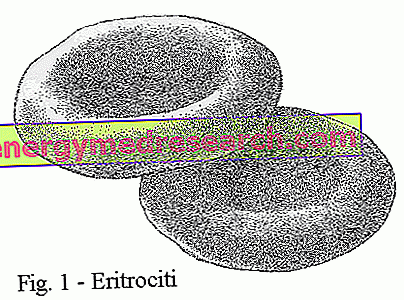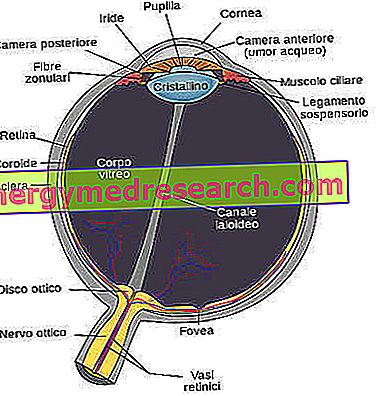The blood is formed by a suspension of cells in a liquid called plasma . 55% of the blood consists of plasma, 45% of cells also called haemocytes .
The plasma is made up of water, mineral salts and colloidal proteins.
The cellular elements of the blood are divided into red blood cells, white blood cells and platelets. The number of red blood cells is greater than that of white blood cells.
In an adult man, the blood constitutes about 1/12 of the body weight and corresponds to 5-6 liters, heavier than water has a specific weight of 1.055.
The blood performs numerous and important functions:
- transports nutrients (amino acids, sugars, mineral salts) to the tissues
- transports oxygen to the various tissues and draws carbon dioxide (CO 2)
- transports the waste products that will be eliminated through the kidney filter
- it also carries hormones, enzymes and vitamins
- represents a defense system of the organism
Plasma
Plasma is a slightly alkaline fluid (pH> 7), with a characteristic yellowish color, consisting mainly of water (90%) and dry substance (10%). Plasma contains numerous organic substances such as glucides, lipids, proteins, amino acids, vitamins, hormones and mineral salts.
Erythrocytes (red blood cells)
Erythrocytes are the most numerous blood cells: about 4-6 million / mm 3. They are also called red blood cells or red blood cells. Red blood cells have no nucleus. The lack of the nucleus leaves more space to hemoglobin, a protein responsible for transporting oxygen. The formation of red blood cells (erythropoiesis) follows a circle lasting about 7 days. Red blood cells have an average life of 120 days.

Platelets
Platelets are blood cells, with no nucleus that are produced by the bone marrow.
The main function of platelets, or thrombocytes, is to stop the loss of blood in wounds (haemostasis). For this purpose, they aggregate with each other promoting blood coagulation.
Leukocytes (white blood cells)
White blood cells or white blood cells are nucleated blood cells responsible for the defense of the body . They include basophils, lymphocytes, eosinophils, monocytes and neutrophils.
Basophils secrete anticoagulant and vasodilator substances, their main function is to secrete products that mediate the hypersensitivity reaction (allergic reaction).
Lymphocytes are the main constituents of the immune system which is a defense against the attack of pathogenic microorganisms (viruses, bacteria, fungi and protists). Lymphocytes produce antibodies .
Eosinophils attack parasites and engulf antigen-antibody complexes.
Monocytes are macrophage precursors. They are the largest blood cells and also have macrophage activity.
Neutrophils are very active in phagocytizing * bacteria and are present in large quantities in the pus of wounds.
phagocytosis * the way in which the cell "eats" something big that is outside.
CBC
The blood count or blood count is used to evaluate the number of cells in the blood
FUNDAMENTAL PARAMETERS | |
| RED BLOOD CELLS | 4, 500, 000-5, 000, 000 per mm3 (or µL) |
| WHITE BLOOD CELLS | 4, 000-8, 000 per mm3 (or µL) |
| HEMOGLOBIN (Hb) | 14-16 g / dL |
| HEMATOGRIT (Ht) | 40-50% |
| PLATES | 200, 000-300, 000 per mm3 (or µL) |
| MCV | 80-90 fL (or µ3) |
The hematocrit represents the percentage of the volume of blood that is occupied by red blood cells.
MCV from English Mean Corpuscular Volume or Medium Corpuscular Volume indicates the average volume of red blood cells.
| Cell type | Erythrocytes | Neutrophils | Eosinophils | basophils | Lymphocytes | Monocytes | Platelets |
| dimensions | 7-8 μm | 12-14 μm | 12-17 μm | 14-16 μm | 6-15 μm | 16-20 μm | 1.5-3.5 μm |
| Number / mm3 | 4-6 x 106 | - | - | - | - | - | 150000-400000 |
| Leukocyte formula | - | 50-70% | 2-5% | 0.5-1% | 20-40% | 2-10% | - |
| Survival time | 120 days | from 6 hours to some days | 8-12 days | ? | ? | months / years | 8-12 days |
| Function | intravascular | extravascular | extravascular | extravascular | extravascular | extravascular | intravascular |
| Origin | marrow hematopoietic | marrow hematopoietic | marrow hematopoietic | marrow hematopoietic | marrow hematopoietic | marrow hematopoietic | marrow hematopoietic |
Blood tests
Select the blood test of your interest to find out all the details of the exam



